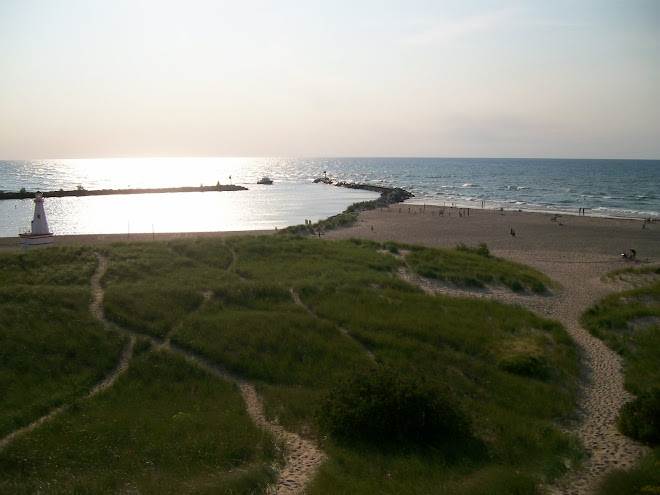 |
| Walloon Lake, from a spot near the Hemingway Cottage |
 |
| From a spot near the Longfield Farm site, looking east across Walloon Lake to the Hemingway cottage site |
Seemingly before he even was of school age, Hemingway loved to fish in the trout streams of northern Michigan. A favorite spot early on was Horton Creek, which flowed into Horton Bay in the nearby lake now called Lake Charlevoix.
 |
| Horton Creek, looking north from the bridge on the Charlevoix-Boyne City Road |
 |
| The Horton Bay General Store, with the "high false front," as Hemingway described it in a story; the Red Fox Inn building sits to the right in the photo |
Hemingway would sometimes sell the trout he caught to Liz Dilworth, who with her husband Jim owed and ran Pinehurst, where for a few years Hemingway often ate and slept. The "resort" property consisted of two small buildings – Pinehurst and Shangri-La – located just south of the Charlevoix – Boyne City Road, about 100 yards up Lake Street from Horton Bay on the north shore of Lake Charlevoix. In 1921, the reception after Hemingway’s marriage to Hadley Richardson was held here.
 |
| Pinehurst in Horton Bay; Shangri-La stands to the right out of the photo |
Hemingway famously set many of his short
stories in northern Michigan, most of them semi-autobiographical featuring his fictional alter-ego
Nick Adams. The Nick Adams Stories span
the protagonist’s life from a young boy living with his parents to a young man with his own son. Many of them are set in the northern Michigan of Hemingway’s youth, notably along the shores of
Walloon Lake and around Horton Bay on Lake Charlevoix.
 |
| Horton Bay, from the foot of Lake Street, looking southwest; in the distance is the finger of land that juts into Lake Charlevoix to form the bay |
From Hemingway's very autobiographical short story Summer People, published posthumously, which describes a clandestine love affair with a young woman named "Kate" who in real life was Katy Smith, who would introduce Hemingway to his first wife, indirectly introduce him to his second wife, and through Hemingway would meet the man who would become her husband, John Dos Passos:Halfway down the gravel road [Lake Street, now paved] from Hortons Bay, the town, to the lake there was a spring. The water came up in a tile sunk beside the road, lipping over the cracked edge of the tile and flowing through the close-growing mint into the swamp. In the dark Nick put his arm down into the spring but he could not hold it there because of the cold. He felt the featherings of the sand spouting up from the spring cones at the bottom against his fingers. Nick thought, I wish I could put all of myself in there. I bet that would fix me. He pulled his arm out and sat down at the edge of the road. It was a hot night."
 |
| The spring in Horton Bay, still there today beside the road |
R Balsamo
[Note: Click on the "Hemingway" link below to see related posts; Also, click on any above photo to enlarge it]
[Note: Click on the "Hemingway" link below to see related posts; Also, click on any above photo to enlarge it]



























